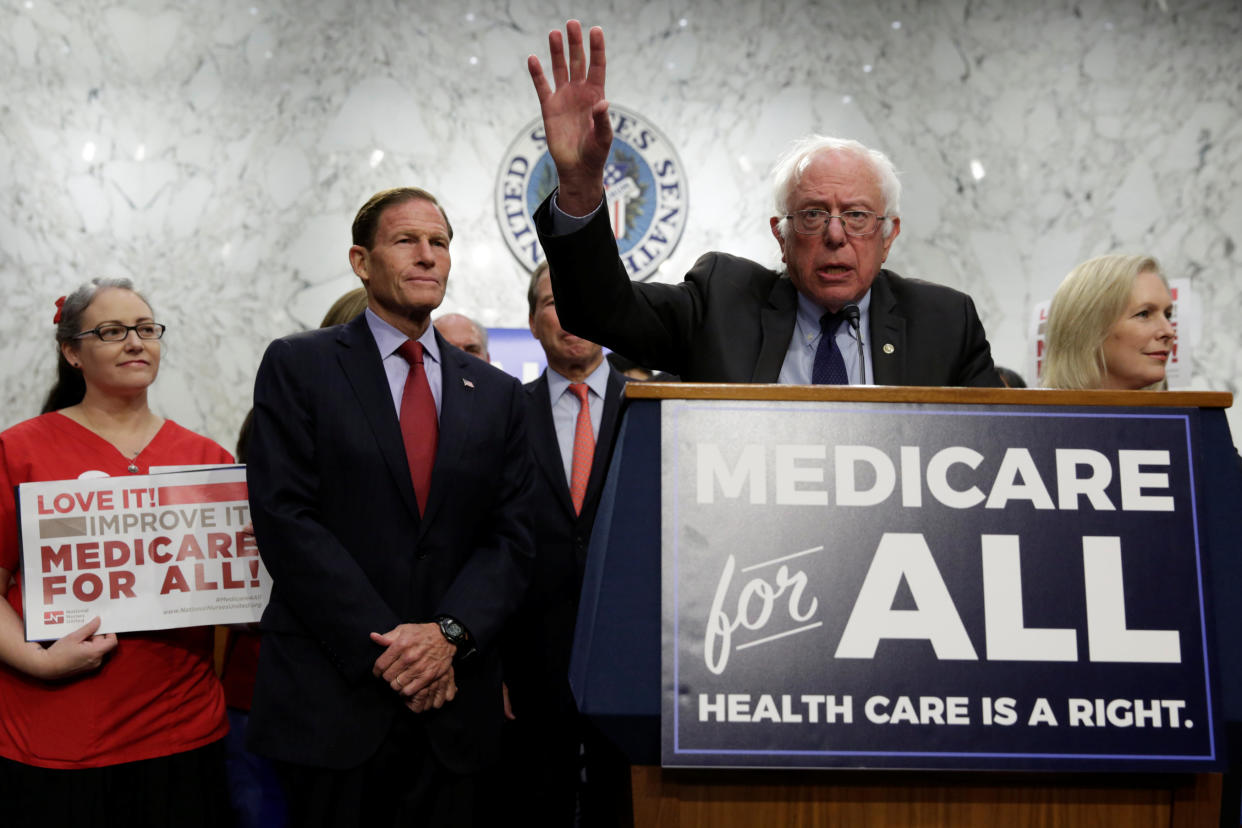Bernie Sanders’ health care plan is headed in the wrong direction

The Democratic party finally has a rallying cry: Medicare for All.
Too bad it’s a hopeless cause.
Sen. Bernie Sanders has turned a key plank of his quixotic presidential campaign into new legislation meant to expand health care coverage to all Americans. It’s a bold idea that addresses a genuine problem, which is why liberal Democrats such as Sens. Elizabeth Warren and Kamala Harris back the idea. But Sanders et. al. are aiming for the impossible when something more plausible could accomplish the same thing.
Sanders wants to scrap the entire private insurance system and enroll everybody in Medicare, the health care program for seniors. Doctors and other providers would stay the same, in theory, but there would be no insurance companies and workers would no longer get coverage through an employer. The elimination of middlemen, along with the government’s enhanced bargaining power, would supposedly lower costs, benefiting everybody (except insurance company employees).
The Sanders model is “single-payer”: The government would pay for everything. It would lead to “universal coverage,” which means everybody would have insurance. But single-payer and universal coverage are not the same thing, and it’s possible to have universal coverage without the government running everything.
Sanders rightly points out that every other developed country has universal coverage for its citizens. Even President Donald Trump has said he’d like to see “insurance for everybody.” But that doesn’t mean a giant government program is the only way to do it.
How to achieve universal coverage
A hybrid system, with both public- and private-sector elements, is probably the most likely path to universal coverage in the United States. Employer-sponsored plans already cover nearly 160 million Americans — half the nation’s population. Rolling everybody off those plans into some kind of government program would be inconceivably complex. The scale of snafus would make the botched rollout of Obamacare in late 2013 look like a well-choreographed ballet.
The employer-sponsored health care system could definitely be cheaper and better, and it imposes the strange burden of providing health care on companies that don’t exist for that purpose. But it’s also one part of the health care system that works reasonably well, and leaving it in place would amount to doing no harm.
The worst part of the U.S. health care system involves people who don’t get coverage from an employer and don’t qualify for Medicare or Medicaid. The 2010 Affordable Care Act addressed that problem by subsidizing insurance premiums for lower-income people and expanding Medicaid. But there are still roughly 28 million adult Americans with no insurance, many who simply find it too expensive. A couple million more don’t qualify for subsidies and pay exorbitant premiums to buy coverage in the individual insurance market. This is where any effort to achieve universal coverage needs to begin.
Counting everybody who receives an ACA subsidy, there are perhaps 40 million Americans who aren’t covered by Medicaid, Medicare or an employer plan. If they could get insurance, we’d have universal coverage, or come very close. Meeting the needs of 40 million people is daunting, but it’s better than dealing with the 200 million who would need insurance if we scrapped the employer system. And the smaller target would require fewer of the tax increases that would be needed to pay for a Sanders-style program.
If the employer-sponsored system remained intact, the government could then be the insurer of last resort for everybody who didn’t get insurance through their job. Some people worry about the creep of “socialized medicine,” but the idea of government-provided catastrophic care has had support among Republicans in the past. The legendary conservative economist Milton Friedman proposed government-provided catastrophic care back in 2001. Mitt Romney, when he was the Republican governor of Massachusetts, put a government-backstop plan in place statewide in 2006. Instead of Medicare for All, the more workable idea is Medicare for More.
What Medicare for All means for prices
Sanders argues that all Americans need to be in the same insurance pool — Medicare — for the government to negotiate the best prices. But there are already 44 million people in Medicare, and 62 million in Medicaid, making them both giant insurance pools. Switzerland boasts lower costs and better health outcomes than the U.S., with a total population of just 8.5 million. Medicare is more bound by laws that limit its bargaining power — on prescription drug prices, for example — than by lack of heft.
Even a hybrid system of universal coverage would be politically difficult to pull off. Critics worry that any effort to expand the government’s role in health care could inevitably lead to a single-payer system, so there would need to be safeguards meant to keep the employer-sponsored system in place. Medicare is due to start running short of money in 2029, and anything that adds to its financial burden will hasten that day of reckoning. Finally, voters usually dislike change, so they’d have to be thoroughly sold on Medicare-for-more to pressure Congress to give it a shot. But Medicare for All might be a start.
Confidential tip line: rickjnewman@yahoo.com. Encrypted communication available.
Read more:
Rick Newman is the author of four books, including Rebounders: How Winners Pivot from Setback to Success. Follow him on Twitter: @rickjnewman


